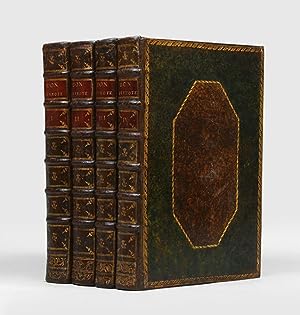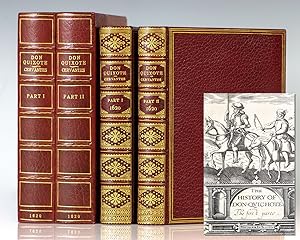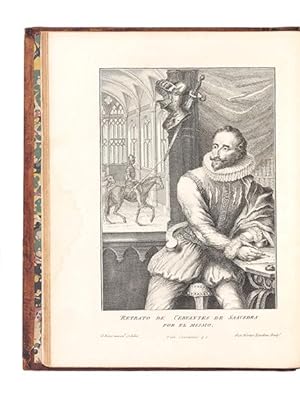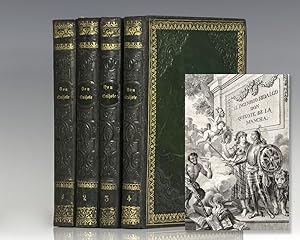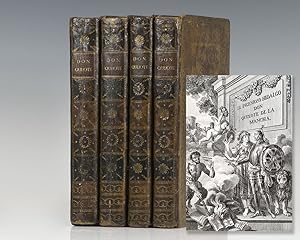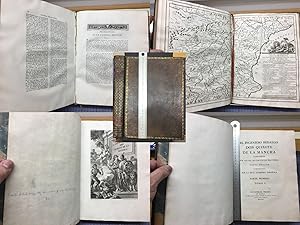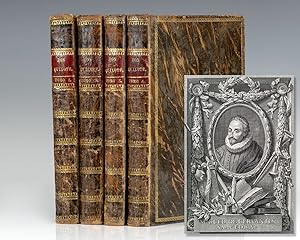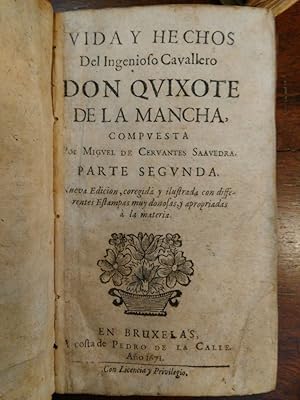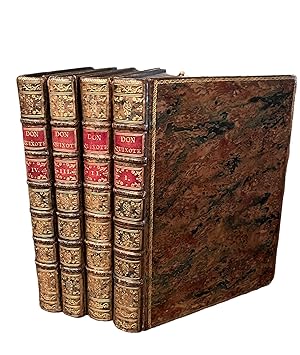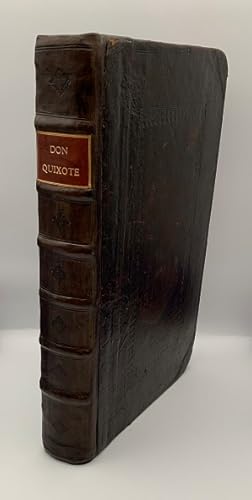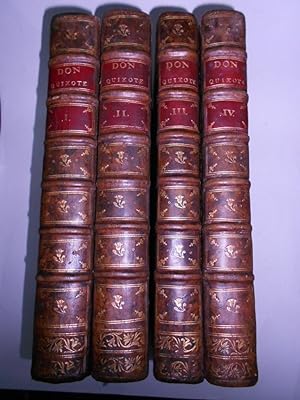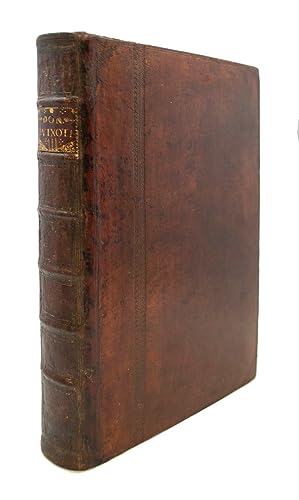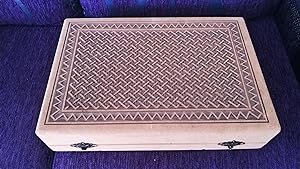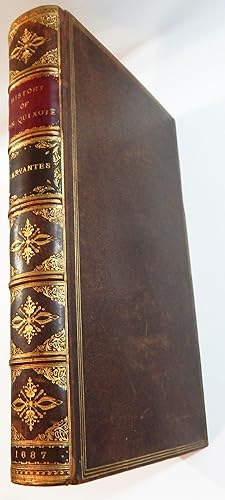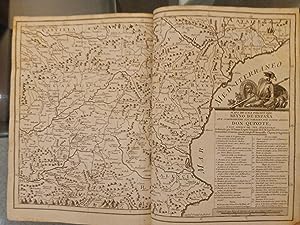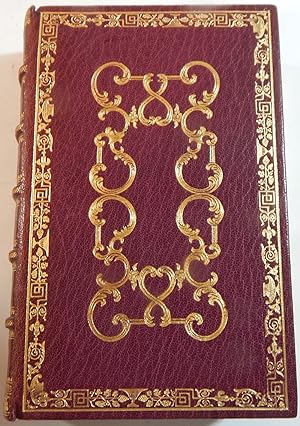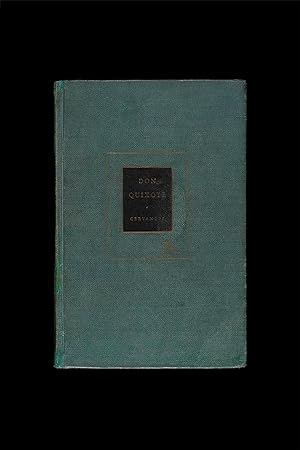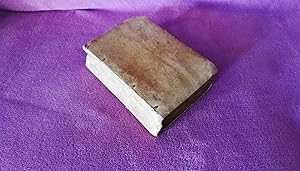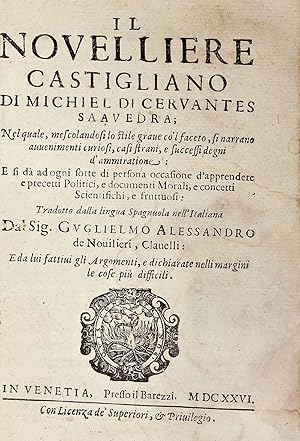miguel de cervantes (Mehr als 13.000 Ergebnisse)
Produktart
- Alle Produktarten
- Bücher (13.577)
- Magazine & Zeitschriften (7)
- Comics (9)
- Noten
- Kunst, Grafik & Poster (36)
- Fotografien
- Karten
-
Manuskripte &
Papierantiquitäten (1)
Zustand
Einband
Weitere Eigenschaften
Gratisversand
Land des Verkäufers
Verkäuferbewertung
-
The History of Don-Quixote. The First Parte. The Second Part of the History of the Valorous and Witty Knight-Errant, Don Quixote of the Mancha. Written in Spanish by Michael Cervantes: and now translated into English.
Verlag: Edward Blount, London, 1620
Anbieter: Raptis Rare Books, Palm Beach, FL, USA
Erstausgabe
Exceedingly rare first complete edition in English of Cervantes' masterpiece comprising the second editionÂofÂtheÂfirst part andÂtheÂfirst editionÂofÂthe second part. Octavo, 2 volumes bound in full 19th century calf, engraved title in each volume. Translated from the original Spanish by Thomas Shelton whose first English translation published in 1612 was the first translation in any language and took him only forty days to complete. The true first edition of Don Quixote was published in Madrid by Francisco de Robles in two parts in 1605 and 1615. Shelton's first English translation first appeared in English in 1612, and was reissued in 1620 along with the first edition of the second part; the engraved title present in both volumes here was created for the second part, and is not present in all copies of the reissued first part. Both volumes are in near fine condition. (Pforzheimer 140; Grolier Langland to Wither 213). In near fine condition. Often cited as the first modern novel, Cervantes' masterpiece Don Quixote remains not only the most influential work of literature to emerge from the Spanish Golden Age, but the most important work of the entire Spanish literary canon. For its influence, innovation and critical status, it is "to Spanish literature what Shakespeare is to English" (Bloom) and has become globally regarded as "one of those universal works which are read by all ages at all times" (PMM). The Shelton translation is generally considered the English translation that "realizes Cervantes' manner more nearly than any successor." (DNB). â It is interesting to realize that the first modern novel was composed by a sick, aged and impoverished man, who believed that a satirical tale might produce more revenue than the poems and plays that he regarded as his more serious mission. Under the guise of a parody on romances of chivalry, Cervantes created a study of reality and illusion, madness and sanity, that links him with such acute 16th-century students of psychology as Erasmus, Rabelais, Montaigne, and Shakespeareâ (Folgerâ s Choice 30).
-
El ingenioso hidalgo Don Quixote de la Mancha; [together with] Segunda parte del ingenioso cavallero don Quixote de la Mancha.
Verlag: Brussels: Rutger Velpius and Hubert Anthoine; Hubert Anthoine, 1611 & 1616, 1616
Anbieter: Peter Harrington. ABA/ ILAB., London, Vereinigtes Königreich
An exceptional ensemble of lifetime editions, pairing the second printing of the second part (published only months after the first), with an early edition of the first part, with text corrections, published six years after the first. The first part was originally published in Madrid by Juan de la Cuesta in 1605; the second part was first published by Cuesta in 1615, the year before Cervantes's death. The first complete edition of Don Quixote, combining both parts with the same date, did not appear until 1617, in Barcelona. The first part here is the second Brussels edition, succeeding the first of 1607. It was published by Rutger Velpius, official printer to the court in Brussels, and his son-in-law Hubert Anthoine, who worked together from 1601 onwards. Based on the second Cuesta edition, it corrected several obvious errors in the text, although, astonishingly, only two of those corrections found their way into the third Cuesta edition of 1608. Velpius died around 1614-15, leaving Hubert Anthoine to succeed him. Anthoine's edition of the second part was published only a few months after the princeps by Cuesta and follows it closely. Brussels was a natural locus for publication of Don Quixote in northern Europe, as it was then under Hapsburg suzerainty as one of the capitals of the Spanish Netherlands. Don Quixote is a landmark of Western literature and one of the most-translated books in the world. "It was the variety, the liveliness, and the gibes at the famous, which won it instant fame. Within months Don Quixote and Sancho Panza had become legendary. Don Quixote is one of those universal works which are read by all ages at all times, and there are very few who have not at one time or another felt themselves to be Don Quixote confronting the windmills of Sancho Panza at the inn" (PMM). Salva 1551 & 1553; Ruis 10 & 13; see Printing and the Mind of Man 111 (first ed. Madrid 1605). 2 separately published parts, octavo (vol. I, 163 x 103 mm; vol. II, 163 x 93 mm). Early 18th-century calf, decorated in similar style but not exactly matching, both with raised bands with elaborate gilt tooling in compartments, twin red morocco labels added sometime later (one since renewed), covers of vol. II bordered with a single gilt rule and board edges gilt, vol. II with French curl pattern marbled endpapers, edges sprinkled red. Housed in a dark brown quarter morocco solander box by the Chelsea Bindery. Woodcut historiated and floriated initials, head- and tailpieces. Title page of vol. I with bookplate of the Lycée Louis-le-Grand, Paris, and ownership inscription " " ("De Jin"), probably the French orientalist Joseph de Guignes (1721-1800); the pair latterly in the extensive library of Andre Gutzwiller (fl. 1958-1994), Swiss banker and bibliophile, with his bookplate to front pastedowns. Frequent annotations in French in ink, pencil, and red crayon (different hands) to both volumes. Bindings square and firm, joints of both volumes and two corners of vol. I skilfully repaired, a little loss of calf to edge of rear board of vol. I, title pages laid down on a later sheet, vol. I with closed tear to margin of three leaves and one margin with crude early repair (loss of initial letter on 11 lines), four small ink burns with loss of a few letters, occasional marks to contents, otherwise generally clean. An attractive set.
-
The History of Don Quixote.
Anbieter: Sokol Books Ltd. ABA ILAB, London, Vereinigtes Königreich
Buch Erstausgabe
Hardcover. Zustand: Very Good. 1st Edition. FIRST COMPLETE NOVEL IN ENGLISH London, Printed for Edward Blounte, 1620?, 1620. FIRST COMPLETE EDITION IN ENGLISH, FIRST EDITION of II. 2 vols. I: pp. [12], 572, [4]; II: [2], [16], 504, lacking final blank. Roman letter, little Italic. Engraved titles with Don Quixote and Sancho Panza on horseback, woodcut vignette to second title, decorated initials and ornaments. Textblock trimmed close at head, occasionally touching typographical ruling, or running title of vol.II, engraved titles and last versos dusty, upper outer corner of P7 (II) torn, affecting two letters, small light water stain to lower outer blank corner of last two ll. (II), the odd minor marginal spot or mark. Very good, fresh and clean copies in modern limp vellum antique by B. Middleton, silk ties, a.e.r., early shelfmark labels preserved at foot of spines, bookplates of Kenneth Rapoport and Michael Curtis Phillips. In folding box. The first complete edition in English, and the first English edition of Part II, of this ground-breaking literary work - the first modern European novel, rarely found complete, as a uniform set. Attributed to Renold Elstrack, the engraved frontispiece, which reprised the title vignette of the first 1618 French edition, was the illustration of Don Quixote and Sancho to appear in print. Don Quixote is one of those universal works which are read by all ages at all times, and there are very few who have not at one time or another felt themselves to be Don Quixote confronting the windmills or Sancho Panza at the inn (PMM 111). The epic novel tells the deeds of the minor aristocrat Alonso Quijano, so keen a reader of medieval chivalric romances that he loses his mind (or pretends to), and becomes absorbed in an imaginary world of knightly adventures. After assuming the name Don Quixote , as a knight-errant, he travels with his witty squire Sancho Panza (a local farmer), facing comic situations he interprets as heroic, including the famous, symbolic and now proverbial fight against windmills. Miguel de Cervantes Saavedra (1547-1616) led a picaresque life. Having written a handful of plays, he published Part I of Don Quixote in 1605, followed by Part II in 1615. It was first translated from Castilian into English the first translation into any language - by the Irish Catholic Thomas Shelton (fl.1604-20) in 1612, using the text of the 1607 edition, printed in Brussels, where Shelton taught Spanish. The c.1620 Part I is a reprint of Shelton s text. Previously attributed to Shelton and probably based on the 1615 edition, Part II is now considered to be the work of the Hispanist Leonard Digges (1588-1635). Digges was among the authors of dedicatory poems prefacing Shakespeare s First Folio, also published by Edward Blount. The English translation of Quixote greatly influenced the language and ideas of English playwrights and poets, including Shakespeare and Jonson. Not merely once but on a variety of occasions the C17 English writers [influenced by Quixote ] reflect and actually participate in the sheer fun of the work by playing with the protagonist s name. They invent the adjectives Quixoticall (1642), Quixot-like (1664) [ ]; the past participle Don quixoted (1658) [ ]; and the nouns Don Quichoterie (1659), Quixotry (1665) [ ]. In short, both the nature and the contagious fun of the character [ ] were actually adapted, incorporated, and made manifest in fresh English words (Randall, pp.xxxvi-xxxvii). I: STC (2nd ed.), 4917; Pforzheimer, 140; ESTC S107641; PMM 111 (first Spanish ed.). II: STC (2nd ed.), 4917; Pforzheimer, 140; ESTC S107642; PMM 111 (first Spanish ed.). M. Cervantes de Saavedra, The History of Don Quixote of the Mancha, vol. III (1896); D. Randall, Cervantes in seventeenth-century England (2009).
-
El Ingenioso Hidalgo Don Quixote de la Mancha.
Verlag: Roger Velpius, 1607
Anbieter: Blackwell's Rare Books ABA ILAB BA, Oxford, Vereinigtes Königreich
woodcut initials and ornaments, paper-flaw at lower outer corner of L2 (no loss to text), a bit of ink staining on R4r, occasional light browning, a few mild damp-stains in the margins, ?wax stain on front fly-leaf affecting the title-page slightly, pp. [xxiv], 592, [8], 8vo, contemporary calf, double gilt fillets on sides, arms (unidentified: Franco-Belgian?) blocked in gilt to both covers, that on the upper cover with a little loss of gilt, that on the lower good and bright, flat spine with a border of double gilt fillets, headcaps defective, cracking to joints, rear endpapers sometime renewed (not, apparently, very recently) preserved in a fine red morocco backed folding box by Trevor Lloyd. Rare, especially in commerce. A complete copy in a fine contemporary binding of the first Brussels (first extra-Iberian) edition of the novel "which is to Spanish literature what Shakespeare is to English" (Bloom). Ruiz notes that this edition was the most finely printed of the early versions to date. Don Quixote won immediate fame when first printed in 1605 for its "variety, liveliness, and gibes at the famous. "Its subdued pathos and universal humanity have assured it a place as "one of those universal works which are read by all ages at all times" (PMM). It quickly went through numerous editions,and translations. This edition is the seventh overall - all early editions are rare. Velpius's edition, which introduced the text to Northern Europe, is based on Cuesta's second of 1605, with many misprints and other textual infelicities corrected, and itself 'corregido con cuidado' (Palau). RBH and ABPC record only 3 other copies at auction in the last 30 years. In Maggs's 1927 catalogue a copy in a Zaehnsdorf binding (with the second part) was priced £52 10s. The second part, which Cervantes wrote in response to spurious sequels, appeared 10 years later. The arms feature as 'unidentified' at the end of vol. 15 of 'Manuel de l'Amateur de Reliures Armoriées Françaises' (with thanks to Dr Sara Trevisan pointing us there). (CCPB000042471-4; Palau 51981; Ruiz 7; USTC 5039050; cf. PMM 111).
-
Segunda parte del ingenioso cavallero Don Quixote de la Mancha.
Verlag: Barcelona, Sebastian Matevat, 1617
Erstausgabe
Couverture souple. Zustand: Très bon. Edition originale. CERVANTES Saavedra, Miguel de. [DON QUICHOTTE]. SEGUNDA PARTE DEL INGENIOSO CAVALLERO DON QUIXOTE DE LA MANCHA. Por Miguel de Cervantes Saavedra, autor de su primera Parte. Dirigida a Don Pedro Fernandez de Castro. Barcelona, Sebastian Matevat, Ano 1617. In-8 de (6) ff., 357 ff., (9) pp. de table. Vélin ivoire à recouvrement de l époque, traces d attache, dos à deux nerfs, titre calligraphié au dos, tranches jaspées. Reliure de l époque. 145 X 97 mm. « Rarissime édition, la première dont les deux parties aient été imprimées dans la même ville et sous la même date. Navarette n en connut que le second volume, et Salva affirme n avoir jamais vu que son exemplaire de complet. » (Ricardo Heredia). Ricardo Hérédia, n°2518 ; Salva, n°2654 ; Palau, 51989 ; Brunet, I, 1749 ; Graesse, II, 106 ; Rahir, Bibliothèque de l amateur, 360. L exemplaire était en reliure très postérieure. PREMIERE EDITION BARCELONAISE DE LA SECONDE PARTIE DE DON QUICHOTTE parue deux ans après l originale de Madrid. De tous temps les deux parties se sont vendues séparément. Il suffit pour s en convaincre de consulter Salva, Ricardo Heredia ou Brunet. Cela s explique par les 10 années qui séparent la publication des deux parties et par leur faible tirage. LA SECONDE PARTIE DE DON QUICHOTTE EST BIEN PLUS QU UNE SUITE, C EST UN LIVRE COMPLET EN LUI-MEME « qui est en quelque sorte l illustration, l interprétation et la conclusion définitive de la première ». La renommée triomphale de la première partie encouragea Cervantès à produire un nouveau chef-d uvre. CETTE EDITION EST DECRITE DANS LA COLLECTION LA PLUS COMPLETE DES UVRES DE Cervantès REUNIE AU XIXE SIECLE PAR Ricardo Hérédia, comte de Benahavis dont la vente eut lieu à Paris en 1892. Celui-ci possédait les 10 premières éditions de la première partie, l originale de Madrid de la seconde partie, publiée en 1615, 2 exemplaires de la seconde édition imprimée à Bruxelles en 1616, puis celle de Barcelone de 1617, mais en reliure très postérieure. « Chef d uvre de la littérature mondiale, Don Quichotte a été pensé par son auteur comme un roman de chevalerie capable de se détacher de tous les autres. Après avoir fourbi les vieilles armes de ses ancêtres et s être fabriqué une visière en carton Alonso Quixano prend comme nom de bataille celui de Don Quichotte de la Manche. Un jour il monte à cheval et part à l aventure. L uvre entière est comme enveloppée d un sourire immatériel et translucide qui laisse percer secrètement une inépuisable richesse d humanité et d expériences réellement vécues. » (Dictionnaire des Oeuvres). « Within months Don Quichotte and Sancho Panza had become legendary. Don Quichotte is one of those universal books which are read by all ages at all times. » (PMM). L originale de Don Quichotte est, avec celle de Shakespeare, la plus recherchée de la littérature mondiale. En novembre 1989, à New York, il y a 25 ans, ces deux originales, reliées en maroquin du XIXe siècle, étaient respectivement adjugées $ 1 650 000 et $ 2 000 000. La seconde partie seule de Don Quichotte, imprimée à Madrid en 1615, en vélin de l époque a été adjugée 600 000 le 7 décembre 2000 (Sotheby s), il y a 14 ans. MAGNIFIQUE EXEMPLAIRE, DE TOUTE PURETE, CONSERVE DANS SA RELIURE EN VELIN IVOIRE DE L EPOQUE. Barcelona, Sebastian Matevat, Ano 1617. In-8 de (6) ff., 357 ff., (9) pp. de table. Vélin ivoire à recouvrement de l époque, traces d attache, dos à deux nerfs, titre calligraphié au dos, tranches jaspées. Reliure de l époque. 145 X 97 mm. « Rarissime édition, la première dont les deux parties aient été imprimées dans la même ville et sous la même date. Navarette n en connut que le second volume, et Salva affirme n avoir jamais vu que son exemplaire de complet. » (Ricardo Heredia). Ricardo Hérédia, n°2518 ; Salva, n°2654 ; Palau, 51989 ; Brunet, I, 1749 ; Graesse, II, 106 ; Rahir, Bibliothèque de l amateur, 360. L exemplaire était en reliure très postérieure. PREMIERE EDITION BARCELONAISE DE LA SECONDE.
-
El Ingenioso Hidalgo Don Quijote de la Mancha.Segunda parte.1617. Lisboa. Jorge Rodriguez
Anbieter: Lauso Books, BARCELONA, Spanien
Pergamino. Zustand: Aceptable. 4? Edición. Encuadernación de tapa blanda. Condición: Aceptable. Inencontrable 4º edición de la segunda parte del Quijote (1617), que vió la luz en Lisboa a pocos meses de la muerte de Cervantes. 8º m.:13 cm x 18,5 cm, encuadernado en pergamino de época. Para esta edición se siguió el texto de la edición de Madrid de 1615, como se aprecia en este ejemplar de Lisboa, se omiten la aprobaciones del ejemplar de Madrid y se incorporan las de Portugal del 12, 22 y 25 de Agosto y 10 de sept de 1616, aunque la tasa se despachó en Lisboa el 17 de enero de 1617.( Ver imágen colgada de la página). Bien sabido es, que la segunda parte del Quijote se publicó por primera vez por Juan de la Cuesta en Madrid , en la imprenta Francisco Robles en 1615. En 1616 fue impresa por 2ª vez por Huberto Antonio en Bruselas y la tercera por Pedro Patricio Mey en Valencia. En 1617 se publicó esta 4ª por Jorge Rodríguez en Lisboa, y esta no iba acompañada de la primera parte. Las dos Partes se editarán conjuntamente pronto: en Barcelona (también en 1617) y en Madrid (1637, 1647, 1655, 1662, 1668 dos veces, 1674 y 1704). EL TALLER DE JORGE RODRIGUES Durante el primer tercio del siglo XVII, Lisboa fue uno de los centros de mayor producción o , mejor, reproducción de obras en castellano. Nombres como Antonio Alvares o apellidos como Craesbeeck son ineludibles en cualquier estudio de la época. Al lado de esos impresores, aunque injustamente sin su fama. Jorge Rodrigues destaca como editor y reeditor de libros en castellano. No sólo publicó las dos partes del Quijote y el Persiles, sino que es el primer editor en Lisboa del Guzmán de Alfarache de Mateo Alemán y del Calateo español de Lucas Gracián Dantisco.También dio a estampa, en sus primeros años, la Primera parte del tesoro de divina poesía de Esteban Villalobos, en 1598, la continuación del Guzmán de Mateo Lujan de Sayavedra en 1603, y la primera parte de las Comedias de Lope de Vega, en 1605, entre muchos otros. Su olfato comercial también le llevó a publicar las obras religiosas más famosas de la época, como el Contemptus mundi de fray Luis de Granada, de 1623, auténtico best-seller por esos años, o el Paraíso de la gloria de los santos de fray Diego de la Vega, que publicó en colaboración con Pedro Craesbeeck, en 1603. Tomadas como botón de muestra, a las que podríamos sumar bastantes más títulos, las publicaciones aducidas hacen patente que Jorge Rodrigues estaba muy al día de la literatura en castellano de su época. Siendo así, la aparición de las obras de Cervantes no es una mera casualidad sino que responde a una de las "líneas editoriales" favoritas y, seguramente, más rentables de esa imprenta. Estado del libro: Algunos puntos de polilla extinta, errores en la numeración de algunos folios pero texto completo. Algunas puntas de hojas con pequeñas faltas. Pueden solicitar alguna imagen adicional. Texto en dos columnas. Bello y exclusivo ejemplar. Ver las imágenes. Lauso Books es una joven librería on-line dedicada a la compra venta de libros, que son nuestra pasión. Nos enfocamos en dar un servicio personalizado, ágil y de calidad a nuestros clientes, dando respuestas rápidas y velocidad en los envíos. Las valoraciones de nuestros compradores satisfechos son nuestra mejor carta de presentación. Trabajamos para que nuestra seña de identidad sea una gran experiencia de compra y una perfecta comunicación cliente-librería. Le agradecemos de antemano su visita, y recuerde que El regalo de un libro, además de obsequio, es un delicado elogio .
-
The First Part of the Life and Achievements of the Renowned Don Quixote de la Mancha.
Verlag: By William Stansby For Ed: Blounte, London, 1620
Anbieter: Raptis Rare Books, Palm Beach, FL, USA
Signiert
Rare second edition of the first part of Don Quixote in English. Octavo, bound in contemporary calf, engraved title page, woodcut headpieces and decorative initials. In very good condition with some wear to the binding, portion of upper spine. Translated by Thomas Shelton. Exceptionally rare and desirable. Don Quixote tells the tale of a man so entranced by reading about the chivalrous romantic ideals touted in books that he decides to take up his sword and become a knight-errant himself, with the aims of defending the helpless and warding off the wicked. With his somewhat confused laborer-turned-squire, Sancho Panza, they roam the world together and have adventures that have haunted reader's imaginations for nearly four hundred years. Don Quixote is generally recognized as the first modern novel. Over those years, it has had an incredible influence on thousands of writers, from Dickens to Faulkner, who once said he reread it once a year, "just as some people read the Bible". Vladimir Nabokov is quoted as saying, "Don Quixote is greater today than he was in Cervantes's womb. [He] looms so wonderfully above the skyline of literature, a gaunt giant on a lean nag, that the book lives and will live through [his] sheer vitality. He stands for everything that is gentle, forlorn, pure, unselfish, and gallant. The parody has become a paragon.".
-
Two volumes, 8° (188x118 mm). I. Collation: †10, ††4, A-Z8, Aa-Pp8, Qq4. [28], 611, [5] pages. II. Collation: *8, A-Z8, Aa-Ss8. [16], 649, [7] pages (pages 529-576 misnumbered 525-572). Roman and italic type. Two engraved titles included in the foliation, and sixteen full-page engraved plates, in total. Uniformly bound in contemporary calf, over pasteboards. Spines with five raised bands, tooled in gilt; title lettered in gold. Marbled edges. Extremities of the spine and joints restored. Tooling and title on the spine somewhat faded. A very good, tall, and genuine copy. Leaves slightly and uniformly browned. In the first volume, skilful repair to the upper margin of the third plate with no damage to the engraving.An extremely rare and important edition of this masterpiece of world literature: the first illustrated edition in Spanish, and the second edition in any language – following the Dutch translation published in Dordrecht in 1657 – to feature illustrations. This is the first edition with the new title Vida y hechos, and one of the most important editions in the history of Cervantes novel. The sixteen engravings included in this edition are not signed, but are generally attributed to Frederik Bouttats (ca. 1610-1676) – who was active in Antwerp between 1643 and 1676 – after the Dutch edition of 1657. The text follows the 1637 edition for the first part, and the Madrid 1615 and Valencia 1616 editions for the second part. "The complete edition has 2 frontispieces and 16 chapter illustrations newly engraved by an unknown engraver after Savery's 24 illustrations (Dordrecht: Savery 1657). 8 illustrations from Savery's set have not been copied: 'Andrés' lashes', 'The galley slaves', 'DQ's penance', 'DQ hanged at the inn', 'The enchanted Dulcinea', 'Braying mayors squadron', "Washing beards episode', and "Sancho's judgement'. Cushing's copy has only the 1 frontispiece and 8 chapter illustrations from vol. 1. Río y Rico refers to two illustrations ('Don Quixote knighted' and 'Doña Rodríguez' night adventure') as if they appeared in this edition, but they don't" (Cervantes Collection, Cushing Memorial Library).Palau 51993; Rius, Bibliografia critica de las obras de Miguel de Cervantes, I, no. 20; Río y Rico, no. 42; Peeters-Fontainas 229; Bardon cat. 2005, no. 3 ("Primera ediciòn ilustrada en castellano de gran aprecio y rareza"); P. Lenaghan, Imágenes del Quijote: modelos de representación en las ediciones de los siglos XVII a XIX, Madrid 2003; Cervantes Collection, Cushing Memorial Library (accessed January 2018); Philobiblon, One Thousand Years of Bibliophily, no. 210. Book.
-
Novelas exemplares de Miguel de Cervantes Saavedra. Dirigido a don Pedro Fernandez de Castro, Conde de Lemos, de Andrade y Villalua, &c.
Verlag: Bruxelles, Roger Velpio et Huberto Antonio, 1614., 1614
Anbieter: Librairie Camille Sourget, Paris, Frankreich
Verbandsmitglied: ILAB
Couverture rigide. Zustand: Très bon. Précieuse et rare quatrième édition des Nouvelles exemplaires, dédiée au Comte de Lemos, gouverneur du royaume de Naples. La première avait paru à Madrid l?année précédente. Première édition parue hors d?Espagne. Composées entre la première et la seconde partie de Don Quichotte, les Nouvelles exemplaires représentent le monument le plus achevé de l'?uvre narrative de Cervantès. Le recueil se compose de 12 nouvelles : « La petite gitane », « L?amant généreux », « Rinconète et Cortadillo », « L?espagnole anglaise », « Le licencié Vidriera », « La force du sang », « L?illustre servante », « Les deux jeunes filles », « Cornelia », « Le mariage trompeur », « Le colloque des chiens », « La fausse tante ». Toutes ces Nouvelles ou Contes moraux brossent un tableau achevé de la société espagnole à la manière d?un manuel de savoir-vivre, brodé des perles rares des « entremeses », sorte de sketches alertement troussés qui évoquent avec une étrange résonance psychologique et une amère gaieté une société en dissolution. « Le cadre conventionnel de la nouvelle italienne se brise ici - pour atteindre un équilibre esthétique intérieur qui ne dépend plus de règles apparentes et fixes. Cervantès part de la tradition pour cueillir, au-delà de toute convention, les aspects de cette humanité qui s?agitait sur les places et dans les rues de l?Espagne de son temps. Il arrive à ce résultat par l?emploi de procédés esthétiques entièrement nouveaux, dont il est l?initiateur ; grâce à un dialogue serré et vif, le récit progresse, sans une faille, traduisant fidèlement l?évolution psychologique des personnages ; point de notations qui ne soient déduites, et toujours avec bonheur, de la situation elle-même ; la peinture est sobre, juste ; le style, brillant et précis ; la vie s?y reflète dans ses aspects multiples ; tour à tour tragique et comique ; dans certains récits où s?affrontent les instincts élémentaires de la vie - et qui comptent parmi les meilleurs, - on assiste à la naissance d'une poésie brutale et cependant jamais vulgaire ; car si rien n?échappe au regard pénétrant de l?auteur, rien non plus qui ne soit évoqué avec amertume : mais constamment ce sourire ironique, légèrement résigné, et, somme toute, bienveillant, où s?exprime un amour malheureux mais attentif des hommes. » La rareté des toutes premières éditions des Nouvelles de Cervantès est légendaire et soulignée à juste titre par les bibliographes. Brunet mentionne ainsi qu?en 1828, Salva ne connaissait qu?un seul exemplaire en Espagne de la première édition de 1613. Le bibliographe cite seulement 2 autres exemplaires. La seconde édition est considérée « comme presque aussi rare et aussi recherchée que la première ». La troisième imprimée à Pampelune en 1614 présente la même rareté. Brunet répertorie ensuite cette présente édition imprimée à Bruxelles en 1614 et ne cite que 2 exemplaires : les exemplaires des bibliothèques Hibbert et Heber. Précieux et bel exemplaire de cette édition précoce des nouvelles de Cervantès, de toute rareté en séduisante et rarissime reliure parlante de l?époque portant les lettres majuscules « V » en bas du premier plat et « L. D. B. » en queue du second plat.
-
Milan, Por el Heredero de Pedromartir Locarni y Iuan Bautista Bidello, 1610. 8vo. In contemporary full limp vellum with title in contemporary hand to spine. Extremities with wear. Repair and a small hole to front board and missing vellum on upper outer corner of back board. Previous owner's name in contemporary hand to title-page. First 8 leaves lightly washed. Damp stain throughout, however mainly affecting pp. 169-340. The paper is still good and solid. A good copy in its original binding. [Blank], 16 ff, 722 pp, [blank]. [mispaginated between pp. 704-707, as called for]. Scarce first edition of 'Don Quixote' to be printed in Italy, being the 10th overall printing of part one, preserved in its first binding. The editor changed Cervantes's dedication to the Duque de Béjar for that of Vizconde Vitaliano, otherwise the text follows that of the second edition printed in Madrid by Juan de la Cuesta in 1605. This masterpiece, which established the novel genre in Western literature, was first published by Cuesta in Madrid in 1605 and became an instant success. The first edition, published in Madrid in 1605, was followed by three pirated editions later the same year and two further authorized editions. The first part of Don Quixote was revised by Cervantes up to and including the third Cuesta edition of 1608. The second part was not published until 1615. ?The first part of Don Quixote came out in 1605. What had begun as a simple satire on the tedious chivalric romances of the time broadened into a sweeping panorama of Spanish society and it was this, the variety, the liveliness, and the gibes at the famous, which won it instant fame. Its larger claims, the subdued pathos, its universal humanity, were slower to be appreciated. But within months Don Quixote and Sancho Panza had become legendary [?]. Don Quixote is one of those universal works which are read by all ages at all times, and there are very few who have not one time or another felt themselves to be Don Quixote confronting windmills or Sancho Panza at the inn.? (PMM 111) Brunet 1748 Palau 51983 Suñé 10 (PMM 111, being the first edition from 1605).
-
El ingenioso hidalgo Don Quixote de la Mancha. Nueva edicion corregida por la Real Academia Española.
Verlag: Madrid: Don Joaquin Ibarra, Impresor de Cámera de S. M. y de la Real Academia, 1780, 1780
Anbieter: Peter Harrington. ABA/ ILAB., London, Vereinigtes Königreich
Erstausgabe
First printing of the celebrated Ibarra edition. Printed for La Real Academia Española (the Spanish Royal Academy) by Joaquín Ibarra y Marín, this edition was intended to be a supreme example of Spanish craftsmanship lavished on the nation's greatest literary work. This edition excels in beauty of type, design, paper, illustration and printing, as well as incorporating a carefully edited and corrected text. The illustrations and delightful ornaments were designed by the best Spanish artists of the day, the paper was milled expressly for this edition, and the type was specially cut. It contains the first map depicting the route taken by Don Quixote and Sancho Panza through Spain. The edition's fame among bibliophiles was thoroughly established throughout Europe within a few years. Cohen-De Ricci 218-19; Palau 52024; Updike II, 73-75. 4 volumes, quarto (302 x 222 mm). Contemporary Spanish green mottled calf, twin red morocco labels, gilt floral decoration to compartments, inset brown calf lozenge to covers with gilt borders, marbled endpapers, gilt edges. 4 engraved title pages, portrait of Cervantes, and 31 plates after Carnicero, Barranco, Brunette, Del Castillo, Ferro and Gil, engraved by Ballester, Barcelon, Fabregat, Gil, Mol, Muntaner, Salvador y Carmona and Selam, engraved map, engraved ornamental initials and head- and tailpieces. Lower margin of frontispiece of vol. I sometime renewed (not affecting image). Expert restoration to joints and extremities, inset calf repair to covers, light damp discolouration to endpapers, some foxing to contents, a few faint running peripheral minor stains, more substantial staining at end of vol. IV. A very good copy in a handsome contemporary Spanish binding.
-
The History of Don-Quichote. The First Parte and The Second Part of the History of the Valorous and Witty Knight-Errant, Don Quixote of the Mancha.
Verlag: Printed for Edward Blount, London, 1620
Anbieter: Raptis Rare Books, Palm Beach, FL, USA
Exceedingly rare first complete edition in English of Cervantes' masterpiece comprised of a second edition of the first part and first edition of the second part. Small quarto, bound in full crimson crushed levant morocco by Riviere & Son, gilt titles and elaborate gilt tooling to the spine in six compartments within raised gilt bands, triple gilt ruling to the front and rear panels, gilt turn-ins and inner dentelles, all edges gilt, engraved headpieces, tailpieces and initials. Engraved title pages and printed title page to the second part supplied in exact facsimile from the copy in the British Museum. No printed title was printed in the first volume. Translated from the original Spanish by Thomas Shelton, his first English translation published in 1612 was the first translation in any language, and took him only forty days to complete. The true first edition of Don Quixote was published in Madrid by Francisco de Robles in two parts in 1605 and 1614. The first part of Sheltonâ s first English version was published in 1612 with the second part added in 1620, both published in quarto. Volume one is a second edition of the excessively rare first edition, of which very few copies exist. Volume two is a first edition, lacking the engraved title as with many copies, and believed to be indicative of an earlier state. â Duff suggested that the reason this plate is lacking in so many copies of the second part is because it was not prepared until after a good many copies had been sold without itâ (Pforzheimer 140; Grolier Langland to Wither 213). In near fine condition. Small bookplates. Housed in a custom half morocco and folding chemise slipcase. A stunning presentation of this rare complete first edition in English. Often cited as the first modern novel, Cervantes' masterpiece Don Quixote remains not only the most influential work of literature to emerge from the Spanish Golden Age, but the most important work of the entire Spanish literary canon. For its influence, innovation and critical status, it is "to Spanish literature what Shakespeare is to English" (Bloom) and has become globally regarded as "one of those universal works which are read by all ages at all times" (PMM).
-
Engraved frontis. port. of Cervantes by Virtue, several engraved head-pieces, & 67 engraved plates. xxiii, [8], [xxv]-xxxii, vi, [2], 90, [14] (first leaf a blank), 355 pp.; xii, 388 pp. Two vols. Large 4to, cont. speckled calf (joints very expertly repaired), spines gilt, brown & green morocco lettering pieces on spines. London: J. & R. Tonson & R. Dodsley, 1742. First edition of this esteemed translation and a wonderful association copy; this set belonged to Edward Gibbon and bears his bookplate in each volume. Gibbon was known for the wide range of his reading and he refers to this work in several of his letters and writings. He clearly liked this text; he owned an Ibarra edition in Spanish (1782), two editions of Smollett's translation (1755 and 1770), and the present edition. Jarvis (1675-1739), was a portrait painter and translator. A part of the literary circle of Addison, Pope, and Swift, his stylized portraits of society ladies were very fashionable. Jarvis advised Sir Robert Walpole in forming his art collection and was appointed king's painter in 1723. "His major literary undertaking was an English translation of Cervantes' Don Quixote. Published posthumously in 1742 and frequently reprinted, it is generally acknowledged as being close in spirit to the original."-ODNB. The superb engravings are mostly signed by John Vanderbank (1694-1739), painter and draughtsman. They were first used in the 1738 quarto edition of Don Quixote issued by the Tonsons in the original Spanish. The 90 pages in Vol. I print the first English translation of Mayans & Siscar's important Life of Cervantes. Fine and handsome set with his fine armorial bookplate in each volume. Minor rubbing and wear to extremities.
-
El Ingenioso Hidalgo Don Quixote de la Mancha: Nueva Edicion, Corregida Por La Real Academia Española.
Verlag: Don Joaquin Ibarra, Madrid, 1780
Anbieter: Raptis Rare Books, Palm Beach, FL, USA
The deluxe illustrated Ibarra edition of Cervantes' masterpiece. Quartos, 4 volumes. Bound in full 19th century green morocco with central motif and cornerpieces stamped in blind to the panels, gilt titles and tooling to the spine, elaborate double-ruled gilt borders, marbled endpapers, all edges gilt, engraved frontispiece to each volume and 31 engraved plates throughout, 2-page folding engraved map of DonÂQuixote's travels to the rear of volume 1. Spanish printer JoaquÃn Ibarra made several important technical developments in press printing, book-making, typography and paper-making. In his printed work, Ibarra sought to achieve a perfect flow of harmonious type, inks, illustration, margins, and textures. He worked with the best painters and engravers of his time and, based on a secret formula he developed, the Ibarra ink gained a reputation for its exceptional quality and brilliance. The present volume was printed onÂ"ex profeso" paper with melted types of "ex novo" on the pages, both of which Ibarra created in his Madrid workshop specifically for this project. In near fine condition. A superior example of Ibarra's best-known work. Don Quixote tells the tale of a man so entranced by reading about the chivalrous romantic ideals touted in books that he decides to take up his sword and become a knight-errant himself, with the aims of defending the helpless and warding off the wicked. With his somewhat confused laborer-turned-squire, Sancho Panza, they roam the world together and have adventures that have haunted reader's imaginations for nearly four hundred years. Don Quixote is generally recognized as the first modern novel. Over those years, it has had an incredible influence on thousands of writers, from Dickens to Faulkner, who once said he reread it once a year, "just as some people read the Bible". Vladimir Nabokov is quoted as saying, "Don Quixote is greater today than he was in Cervantes's womb. [He] looms so wonderfully above the skyline of literature, a gaunt giant on a lean nag, that the book lives and will live through [his] sheer vitality. He stands for everything that is gentle, forlorn, pure, unselfish, and gallant. The parody has become a paragon." Printed for La Real Academia Española (the Spanish Royal Academy) by JoaquÃn Ibarra y MarÃn, this edition was intended to be a supreme example of Spanish craftsmanship lavished on the nation's greatest literary work. This edition excels in beauty of type, design, paper, illustration and printing, as well as incorporating a carefully edited and corrected text. The illustrations and delightful ornaments were designed by the best Spanish artists of the day, the paper was milled expressly for this edition, and the type was specially cut. It contains the first map depicting the route taken by Don Quixote and Sancho Panza through Spain. The edition's fame among bibliophiles was thoroughly established throughout Europe within a very few years. The English bibliomane William Davis wrote in 1821 that "the celebrated Ibarra edition is so well known, that I need only refer to M. Paris's sale, 1791, where a copy sold for £16, 16 shillings, and Col. Stanley's, where a copy sold for £17, 6 shillings, 6 pence" (A Journey Round the Library of a Bibliomaniac).
-
El Ingenioso Hidalgo Don Quixote de la Mancha: Nueva Edicion, Corregida Por La Real Academia Española.
Verlag: Don Joaquin Ibarra, Madrid, 1780
Anbieter: Raptis Rare Books, Palm Beach, FL, USA
The deluxe illustrated Ibarra edition of Cervantes' masterpiece "which is to Spanish literature what Shakespeare is to English" (Bloom). Quartos, 4 volumes. Bound in full contemporary Spanish tree calf with gilt titles and tooling to the spine, red and black morocco spine labels, elaborate double gilt-ruled borders, marbled endpapers, all edges gilt, engraved frontispiece to each volume and 31 engraved plates throughout, 2-page folding engraved map of DonÂQuixote's travels to the rear of volume 1. Spanish printer JoaquÃn Ibarra made several important technical developments in press printing, book-making, typography and paper-making. In his printed work, Ibarra sought to achieve a perfect flow of harmonious type, inks, illustration, margins, and textures. He worked with the best painters and engravers of his time and, based on a secret formula he developed, the Ibarra ink gained a reputation for its exceptional quality and brilliance. The present volume was printed on "ex profeso" paper with melted types of "ex novo" on the pages, both of which Ibarra created in his Madrid workshop specifically for this project. In near fine condition with ownership inscriptions and some toning to the page edges, some loss to the edges of the license page. A very bright example of both Cervantes' and Ibarra's best-known works, rare and desirable in this condition. Often cited as the first modern novel, Cervantes' masterpiece Don Quixote remains not only the most influential work of literature to emerge from the Spanish Golden Age, but the most important work of the entire Spanish literary canon. First published in 1605, Don Quixote gained immediate popularity in Spain for its "variety, liveliness, and gibes at the famous" while Cervantes' universal portrayal of the human condition has cemented its status as "one of those universal works which are read by all ages at all times" (PMM). The Ibarra edition swiftly became the preferred edition in Spain when it appeared in 1780 (Palau, 52024). â It is interesting to realize that the first modern novel was composed by a sick, aged and impoverished man, who believed that a satirical tale might produce more revenue than the poems and plays that he regarded as his more serious mission. Under the guise of a parody on romances of chivalry, Cervantes created a study of reality and illusion, madness and sanity, that links him with such acute 16th-century students of psychology as Erasmus, Rabelais, Montaigne, and Shakespeareâ (Folgerâ s Choice, 30).
-
EL INGENIOSO HIDALGO DON QUIJOTE DE LA MANCHA COMPUESTO POR. . . NUEVA EDICIÓN CORREGIDA POR LA REAL ACADEMIA ESPAÑOLA. CON PERMISO SUPERIOR (4 tomos, completo)
Verlag: Joaquin Ibarra, Madrid., 1780
Anbieter: Nayco Libreria, Sevilla la Nueva - Madrid, Spanien
Buch
Encuadernación de tapa dura. Zustand: Excelente. Por Joaquín Ibarra impresor de Cámara de S. M. Y de la Real Academia, EN MADRID, 1780. Folio (30 cms).- 4 tomos.- Encuadernado en plena piel, pasta española, de época, con papel de guardas igualmente contemporáneo (modelo plegado español) con ex-libris de John Milford, (lomera del tomo I ligeramente cuarteada, las del resto en muy buen estado). Lomos con doble tejuelo, filetes y semillado dorado; planos con ruedas doradas; cortes dorados. TOMO I.- 1 lámina frontis grabada.+ 1 hoja de Portada + XIV de Prólogo de la Academia. + 1 lámina grabada, retrato de Cervantes + CCXXIV páginas que comprenden: Vida de Miguel de Cervantes Saavedra, y análisis de Quijote + 199 pags. + retrato + mapa doble página + 6 láminas. Tomo II: Frontispicio + 2 hojas + 418 páginas + 9 láminas. Tomo III: Frontispicio + portada + XIV + 306 pags. + 7 láminas. Tomo IV: Frontispicio + 2 hojas incluyendo portada + 346 pags. + 9 láminas. Ilustrado por Carnicero, Selma, Salvador y Carmona. Excelente ejemplar, completo y muy limpio.
-
El Ingenioso Hidalgo Don Quixote de la Mancha: Nueva Edicion, Corregida Por La Real Academia Española.
Verlag: Don Joaquin Ibarra, Madrid, 1780
Anbieter: Raptis Rare Books, Palm Beach, FL, USA
The deluxe illustrated Ibarra edition of Cervantes' masterpiece "which is to Spanish literature what Shakespeare is to English" (Bloom). Quartos, 4 volumes. Bound in full contemporary Spanish tree calf with gilt titles and tooling to the spine, red morocco spine labels, gilt ruled borders, marbled endpapers, all edges green, engraved frontispiece to each volume and 31 engraved plates throughout, 2-page folding engraved map of DonÂQuixote's travels to the rear of volume 1. Spanish printer JoaquÃn Ibarra made several important technical developments in press printing, book-making, typography and paper-making. In his printed work, Ibarra sought to achieve a perfect flow of harmonious type, inks, illustration, margins, and textures. He worked with the best painters and engravers of his time and, based on a secret formula he developed, the Ibarra ink gained a reputation for its exceptional quality and brilliance. The present volume was printed on "ex profeso" paper with melted types of "ex novo" on the pages, both of which Ibarra created in his Madrid workshop specifically for this project. In near fine condition with bookplates to the pastedown of each volume from the Royal Military College, small library stamps. An excellent example of both Cervantes' and Ibarra's best-known works. Often cited as the first modern novel, Cervantes' masterpiece Don Quixote remains not only the most influential work of literature to emerge from the Spanish Golden Age, but the most important work of the entire Spanish literary canon. First published in 1605, Don Quixote gained immediate popularity in Spain for its "variety, liveliness, and gibes at the famous" while Cervantes' universal portrayal of the human condition has cemented its status as "one of those universal works which are read by all ages at all times" (PMM). The Ibarra edition swiftly became the preferred edition in Spain when it appeared in 1780 (Palau, 52024). â It is interesting to realize that the first modern novel was composed by a sick, aged and impoverished man, who believed that a satirical tale might produce more revenue than the poems and plays that he regarded as his more serious mission. Under the guise of a parody on romances of chivalry, Cervantes created a study of reality and illusion, madness and sanity, that links him with such acute 16th-century students of psychology as Erasmus, Rabelais, Montaigne, and Shakespeareâ (Folgerâ s Choice 30).
-
Vida y hechos del Ingenioso Cavallero Don Quixote de la Mancha
Verlag: Bruselas, Pedro de la Calle. Link para imágenes: https://youtu.be/AMf5CwLxOLE, 1671
Anbieter: Alberto Casares, Buenos Aires, BUE, Argentinien
Verbandsmitglied: ALADA
Buch
Encuadernación de tapa dura. Zustand: Excelente. In 8º, 616 y 656 pp Dos volúmenes. Ilustraciones en frontispicio de cada tomo y en el interior.
-
El Ingenioso Hidalgo don Quijote de la Mancha, compuesto por Nueva edición corregida por la Real Academia Española
Verlag: Madrid, por don Joaquín Ibarra, impresor de Cámara de S.M., 1780
Anbieter: Delirium Books · Susana Bardón, Madrid, Spanien
Buch
Encuadernación de tapa dura. Zustand: Excelente. Fol. (29,5 x 21,5 cm) 4 vols. Encuadernación de época en plena piel marmoleada, rueda dorada en ambos planos, lomos con nervios, hierros dorados en los entrenervios y doble tejuelo rojo: don quixote. I: Frontis, 2 h., XIV p., CCXXIV- 199 p., retrato, mapa y 6 láminas. II: Frontis, 1 h., 418 p., 9 láminas. III: Frontis, XIV-306 p., 7 láminas. IV: Frontis, 2 h., 346 p., 9 láminas. Sobra decir que se trata de la primera edición de la Academia Española, la más estimada de todas las ediciones del Quijote sin duda alguna, publicada por Ibarra con gran gusto, lujo y suntuosidad. Las láminas son obra de los mejores artistas del momento: Carnicero, Selma, Salvador y Carmona, Ballester. La Academia decidió que su primera edición sería la mejor jamás publicada. La impresión se encargó al taller de Ibarra, impresor de Cámara, se fundieron tipos especiales, se fabricó un papel especial y se convocó un concurso para su ilustración. Siete años después de iniciarse el proyecto la edición vería la luz. Palau, 52024; Rius, 53; Salvá, 1564; Cohen, 218-219.
-
1880.EL INGENIOSO HIDALGO DON QUIJOTE DE LA MANCHA.RARO 4 VOLÚMENES
Verlag: Montaner Simon, 1880
Anbieter: Lauso Books, BARCELONA, Spanien
Buch Erstausgabe
Encuadernación de tapa dura. Zustand: Excelente. 1ª Edición. 1880.EL INGENIOSO HIDALGO DON QUIJOTE DE LA MANCHA. MONTANER SIMON. 4 TOMOS. EXCLUSIVA. Barcelona. 1880. 4 Vol. En formato de 39 cm x 29 cm cada tomo. Encuadernación en Pergamino con dorados. Encuadernación por MIRALLES. Ilustrada por Don Ricardo Balaca y Don J. Luis Pellicer. La rareza y exclusividad de esta edición del Quijote de la editorial Montaner Simón es que sea en 4 tomos, y su estado de conservación, como salida de la imprenta. Es sin duda la más rara, y desconocida, reiramos, por ser en 4 tomos (y no en 2 tomos como la editorial imprimió de forma habitual el año 1880 y 1883). Seguramente es la más especial en cuanto a su belleza de todas las publicadas en el siglo XIX, y sin duda la más lujosa impresa en la época, por sus detalles en la encuadernación, en los materiales utilizados, el tipo de papel, por sus dimensiones, por su aparato tipográfico, sus 44 láminas en cromolitografía original de la época a todo color, y más de 250 imágenes grabadas al boj, formando cabeceras y colofones de capítulos. Es una obra irrepetible, por el material utilizado para su composición y por el trabajo de los oficiales que la crearon. La editorial y sus propietarios, al igual que los artistas que realizaron las labores de creación de este libro, desaparecieron, dejando un vacío enorme y muchas incógnitas, pero sobre todo dejaron obras de arte, como este quijote en 4 tomos. Es ampliamente conocido, que la editorial, produjo en 1880 varios ejemplares del Quijote en 2 tomos, que son de extremada belleza, y se encuentran con cierta facilidad en el mercado de libros usados y de colección. Pero de esta misma la obra en 4 tomos, solo se produjeron escasos ejemplares para bibliotecas muy selectas que pudieran permitirse el lujo de adquirirlo. Actualmente no se encuentra en el mercado de venta ni un solo ejemplar en 4 tomos, y mucho menos en buen estado, que es este que presentamos. El estado de conservación de estos 4 tomos hace de este ejemplar una pieza muy exclusiva. Emocionante resulta el pasar las hojas en excelente papel y mejor impresión, cuyos 4 volúmenes se adornan con 44 cromolitografías a toda página firmadas por Ricardo Balaca y Luis Pellicer y 252 cabeceras y remates xilográficos, grabados por maestros como J. Gómez, Smeeton, Tilly, Sadurní y Martí. La empresa editorial Montaner y Simón, fundada en Barcelona en 1861 por Ramón de Montaner y Vila y Francisco Simón y Fuente, se dedicó especialmente a publicar en castellano obras monumentales y de bibliófilo. Llegó a ser una de las más importantes de España, sobre todo durante la segunda mitad del siglo XIX y el primer tercio del siglo XX. A lo largo de sus 120 años de existencia elabora un extenso catálogo de publicaciones de mucha calidad y con un gran alcance de distribución. Uno de los ilustradores de este Quijote, Ricardo Balaca (Pintor español, naciodo en Lisboa, 1844; Aravaca, Madrid, 1880), no pudo ver terminado su trabajo en la ilustración del Quijote, puesto que le vino la muerte cuando tenía finalizadas la mitad de las estampas. El retrato de Cervantes que aparece al inicio de la edición es realizado por B. Maura, uno de los maestros grabadores más importantes del momento. Balaca era hijo del también pintor José Balaca y Carrión que en el momento del nacimiento de Ricardo estaba instalado transitoriamente en Lisboa tras haberse exiliado de España por motivos políticos. Su formación artística se inicia en el taller familiar, completándola en la Escuela Superior de Pintura, Escultura y Grabado de Madrid, siendo discípulo de Federico Madrazo. Desde muy joven destacó por sus capacidades para el arte y en 1858, con solo 13 años, participó por primera vez en la Exposición Nacional de Bellas Artes (España), obteniendo mención honorífica. Practicó el dibujo, la ilustración gráfica, el retrato y sobre todo la representación de escenas de batallas, género típico del siglo XVIII que alcanzó un nuevo auge con el romanticismo en el XIX. En la biografía del otro i.
-
The History of the Most Renowned Don Quixote of Mancha: And his Trusty Squire Sancho Pancha, Now Made English according to the Humour of our Modern Language. And Adorned with several Copper Plates
Verlag: Thomas Hodgkin, 1687
Anbieter: Magnum Opus Rare Books, Missoula, MT, USA
Buch Erstausgabe
Hardcover. Zustand: Fine. 1st Edition. First Edition, First Printing of the First illustrated Edition in English of Don Quixote. A beautiful copy bound in full brown calf to period, with raised bands and is elaborately gilt-decorated on the spine. The book has the copper-engraved frontispiece and eight copper-engraved plates, each bearing two images. The book is in great shape. The binding is tight with NO cocking or leaning with minor wear to the boards. The pages are clean with NO writing, marks or bookplates in the book. A wonderful copy in collector's condition. Trades and offers considered.
-
Compuesto por. Nueva edición corregida por la Real Academia Española. Madrid, Ibarra, 1780, 31x23, 4 volúmenes, I- Frontis, Retrato, XIV-CCXXII-199 pp. 6 láminas y 1 mapa plegado (delineado por Tomás López). II- Frontis, 418 pp. 9 láminas. III- Frontis, 306 pp. 7 láminas. IV- Frontis, 346 pp. 9 láminas. Con 14 letras capitulares, 22 viñetas y 20 "culs de lampe". El tomo III tiene una ligera marca de agua en margen superior de primeras hojas, muy buen estado general, ejemplar limpio y con amplios márgenes. Encuadernados en plena piel de época con nervios, tejuelos, hierros en lomera, ruedas en planos y cantos, cortes dorados. Se trata de la mejor edición impresa en el siglo XVIII, adornada con grabados por Carmona, Fabregat, Ballester, Selma, etc., según dibujos originales de los mejores artistas de la época como Carnicero, Brunete, Barranco, etc. Para el texto se siguió el de la segunda edición de Juan de la Cuesta, 1605, cotejándola con otras y modificando algún pasaje. Contiene La Vida de Cervantes y el Análisis del Quijote de Vicente de los Ríos, trabajos muy documentados que dejan atrás todo lo que hasta entonces se había publicado. (35587).
-
History of the Most Renowned Don Quixote of Mancha And his Trusty Squire Sancho Pancha. Now made English according to the Humour of our Modern Language. And Adorned with several Copper Plates. By. J.P.
Verlag: Printed for Thomas Hodgkin and sold by William Whitwood, London, 1687
Anbieter: Heritage Book Shop, ABAA, Beverly Hills, CA, USA
Erstausgabe
The first illustrated edition in English. Also the first Hodgkin printing and the first Edition of John Philips translation. Quarto (12 1/2 x 7 3/4 inches; 317 x 195 mm). [20], 161, [3], [1, blank] pp. According to ESTC the Frontispiece, S3, and 2P3 are integral engravings. The catchwords on the proceeding leaves show this to be true. With seventeen engravings on nine plates, including the frontispiece. With the errata and 3 pages of poems which are often found lacking. Full contemporary calf, rebacked with original spine laid down. Boards tooled in gilt. Red morocco spine label, lettered in gilt. All edges marbled. Previous owner's armorial bookplate and other smaller bookplate on front pastedown. Some minor repair to spine. Internally very clean. Overall a very good copy. "The first illustrated Don Quixote in English, in the translation of John Phillips, Milton's nephew, continuing Milton's disenchantment with chivalric and popular romances. Phillips' translation moves English slang and satire to the Iberian peninsula, to the horror of his contemporaries ("the Language of Billingsgate into the Mouths of Spanish Ladies and Noblemen"); although the illustrations were reused for later English editions, Phillips' text was never reprinted. His version of Cervantes in "the humour of our modern language" (such as "Knighthoods and Shitehoods" and providing Don Quixote with a dose of the clap) seemed too strong for the reading public." (Sotheby's). ESTC R8126. Palau 156. Rius. HBS 68456. $16,000.
-
EL INGENIOSO HIDALGO DON QUIJOTE DE LA MANCHA (CORCHO, CORK)
Verlag: Imprenta Josep Maria Viader
Anbieter: Libreria Anticuaria Marc & Antiques, Sabadell, BCN, Spanien
Encuadernación de tapa dura. Zustand: Excelente. Edición Especial. Sant Feliu de Guíxols. Imprenta Josep Maria Viader. 1955. Cubiertas de Cuero por Carlos Roca. 2 Tomos + Caja Corcho. XVI+163Pág+3h y IX+172Pág+3h. 26x21. Magna edición limitada de 250 ejemplares numerados(Nº54), impresa en tipos góticos sobre hojas de papel de corcho, ilustrada con 34 reproducciones, dibujadas u grabadas por los mejores artistas del siglo XVIII, de la suntuosa edición realizada por la Real Academia Española en el año 1780. Profusión de orlas e iniciales policromadas en oro y a todo color. Perfecto estado de conservación. Ref 10.2 Biblioteca SA.
-
The History of the Most Renowned Don Quixote of Mancha: And his Trusty Squire Sancho Pancha. Now Made English according to the Humour of our Modern Language. And Adorned with several Copper Plates
Verlag: Printed by Tho. Hodgkin, and are to be sold by John Newton, London, 1687
Anbieter: Thorn Books, ABAA, Tucson, AZ, USA
Erstausgabe Signiert
Hardcover. Zustand: Very good. First Illustrated Edition in English. Folio. 18], 616 [i.e. 612], [3] pp. A7 (3rd and 6th l. signed: A2), c2, B-R4, S3, T-2O4, 2P3, 2Q-4I4, 4K2. Translated by John Phillips. With copper-engraved frontispiece & 8 copper-engraved plates, each bearing two images. 19th century full calf, spine tooled & lettered in gilt, gilt inner dentelles; bound by J. Larkin. Plain endpapers. A very good copy. Light rubbing to the calf, frontispiece and title page expertly and nearly invisibly inlaid in paper frames with no loss of text, two of the plates with fore-edges remargined; minor, mostly marginal, foxing and soiling within. Overall a very attractive copy in a lovely example of the binder's art. Laid in are two 19th century manuscript notes from the Rev. Samuel Martin Mayhew of St. Paul's Vicarage to a Mr. Hopkins discussing the volume and translation. .
-
El ingenioso hidalgo Don Quixote de la Mancha. Nueva edicion corregida por la Real Academia Española
Verlag: Madrid, por don Joaquin Ibarra, impresor de cámara de S.M. y de la Real Academia, 1780, 1780
Anbieter: Arteclío S. L., Pamplona, NA, Spanien
4 vols., 30 x 23 cm. Tomo I: [4] + XIV, [2] + CCXXIV +199 pp., [8] h. de láms. + mapa grabado por Tomás López; Tomo II: [6] + 418 pp., [9] h. de láms.; Tomo III: [4] + XIV + 306 pp., [7] h. de láms.; Tomo IV: [6] + 346 pp., [9] h. de láms. Encuadernación: pasta española de la época, con tejuelo en el lomo y filete dorado en los planos. Cortes dorados. Ligeramente rozada. Cada tomo está a su vez custodiado en caja a medida gris, con doble tejuelo en lomo. Procedencia: Bello exlibris con escudo heráldico, en cada uno de los tomos: "Julia Helena Acevedo de Martínez de Hoz", de Montevideo. Los tomos I y III presentan además otro exlibris (posiblemente posterior al anterior) que indica su pertenencia a "José Antonio Larrinaga Uribarrena". Descripción: El tomo I presenta puntos de óxido en el margen superior, sin afectar al texto más que muy ocasionalmente; El tomo II presenta igualmente puntos de óxido en el margen superior, sin afectar al texto más que muy ocasionalmente; El tomo III presenta también puntos de óxido en margen superior, pero en menor medida que en tomos I y II. El cuerpo del texto igualmente muy limpio excepto entre páginas 231-235, con puntos de óxido que afectan al texto. La lámina de p. 58 se insertó con posterioridad; El tomo IV presenta un pequeño taladro de polilla (menguante conforme avanzan las páginas) en esquina superior derecha, sin afectar en absoluto al texto. Presenta algunos puntos de óxido en el margen superior.
-
El Ingenioso Hidalgo Don Quijote de la Mancha
Verlag: Real Academia Española, Madrid, 1819
Anbieter: Thorn Books, ABAA, Tucson, AZ, USA
Hardcover. Zustand: Fine. Small 8vo. 4 volumes, accompanied by the Vida de Miguel de Cervantes Saavedra by Miguel Navarrette for a total of 5 volumes. 175, xxiv, 359; [iv], 410; xxii, 406; vi, [blank], 403pp. and 643, [1] pp. The four volumes of Don Quijote are illustrated with copper plates and a folding copper-engraved map, handcolored; the Vida is illustrated with a copper portrait, one facsimile page of the manuscript, and two engraved family tree charts. Magnificently and uniformly bound by the Spanish master binder Antolin Palomino Alalla in full crimson morocco. The spines are in six compartments with raised bands, intricately tooled in gilt. The boards with gilt rolls on the borders and central designs of gilt arabesques. All edges gilt. Gilt inner dentelles and marbled endpapers. The binding is sumptuous and the tooling is razor sharp. Fine copies in a cloth slipcase. Palomino Olalla (1909-95) was one of the great Spanish binders of the 20th century. A versatile and meticulous artist, teacher, and craftsman, he opened his Madrid workshop in 1942 and became especially renowned for his hand-gilding, mosaic bindings, and marbled paper techniques. The binding on this set is dated 1947, and there is an autograph letter laid in discussing it. In Spanish. .
-
DON QUIXOTE DE LA MANCHA - LIBRO DE ARTISTA
Anbieter: Luxury Pieces Dali, Montgat, BARCE, Spanien
Signiert
Encuadernación de tapa dura. Zustand: Como Nuevo. Libro antiguo de coleccionista Don Quixote de la Macha de Miguel de Cervantes Saavedra ilustrado por Salvador Dalí. Unico ejemplar en todo el mundo firmado, datado, y con dibujo original de Salvador Dalí. Este libro esta encuadernado en tela, ilustrado con dibujos en blanco y negro y color por Salvador Dalí. Firmado por el autor.
-
1A EDICION EN ITALIANO, NOVELAS EJEMPLARES, MIGUEL DE CERVANTES SAAVEDRA 1626
Verlag: Presso il Barezzi., 1626
Anbieter: Libreria Anticuaria Marc & Antiques, Sabadell, BCN, Spanien
Buch Erstausgabe
Encuadernación de tapa dura. Zustand: Excelente. 1ª Edición. Venecia. Presso il Barezzi. 1626. 18X12. 718p. Pergamino. falto de las paginas 719, 720, ultimas. (facsimiladas). Leve polilla. Primerissima edición en ilaliano de las famosas Novelas. Extremadamente raro, escaso. IV Centenario de la Muerte de Cervantes. Ref 3.3 Biblioteca Cervantina. Language: eng.
-
Il Novelliere Castigliano di Michiel di Cervantes Saavedra. Tradotto dalla lingua Spagnuola nell'Italiana Dal Sig. Guglielmo Alessandro de Novilieri Clavelli.
Erscheinungsdatum: 1626
Anbieter: Librairie Camille Sourget, Paris, Frankreich
Verbandsmitglied: ILAB
Couverture rigide. Zustand: Très bon. Venise, Barezzi, 1626.In-12 de (1) f.bl., (8) ff., 720 pp., (1) f.bl. Vélin souple de l'époque, dos lisse avec le titre manuscrit en tête. Reliure de l'époque.154 x 182 mm. --- Première édition italienne de la plus grande rareté des Nouvelles de Cervantès.Graesse, Trésor de livres rares, II, 108 ; Inconnue à Brunet.Cette première traduction italienne est l'?uvre de Guillaume-Alexandre Clavel.Ce dernier étudie à Padoue lorsqu'il entreprend, vers 1625, une série de traductions italiennes d'ouvrages étrangers."Composées entre la première et la seconde partie de ?Don Quichotte', les ?Nouvelles Exemplaires' représentent le monument le plus achevé de l'?uvre narrative de Cervantès."(Dictionnaire des ?uvres, IV, p.790).Le recueil se compose de 12 nouvelles : La Spagnola Inglese, Lo Amante Liberale, Rinconetto e cortadiglio, Il Dottore Vidriera, La Forza del Sangue, Il Geloso da Estremadura, L'illustre Fregona o la fante, La Cingaretta, Le Due Donzelle, La Cornelia, Il Maritaggio Fallace, Novella e colloquio.Toutes ces nouvelles ou contes moraux brossent un tableau achevé de la société espagnole à la manière d'un manuel de savoir-vivre."Le cadre conventionnel de la nouvelle italienne se brise ici pour atteindre un équilibre esthétique intérieur qui ne dépend plus de règles apparentes et fixes. Cervantès part de la tradition pour cueillir, au-delà de toute convention, les aspects de cette humanité qui s'agitait sur les places et dans les rues de l'Espagne de son temps. Il arrive à ce résultat par l'emploi de procédés entièrement nouveaux dont il est l'initiateur: grâce à un dialogue serré et vif, le récit progresse, sans une faille, traduisant fidèlement l'évolution psychologique des personnages; la peinture est sobre, juste; le style brillant, précis; la vie s'y reflète dans ses aspects multiples; tour à tour tragique et comique."(Dictionnaire des ?uvres.)Séduisant exemplaire de cette rare édition originale ita /// Venice, Barezzi, 1626.12mo [154 x 182 mm] of (1) bl. l., (8) ll., 720 pp., (1) bl. l. Contemporary limp vellum, flat spine with handwritten title at the head. Contemporary binding. --- First Italian edition of the utmost rarity of Cervantes's novellas.Graesse, Trésor de livres rares, II, 108; Unknowned to Brunet.This first Italian translation is the work of Guillaume-Alexandre Clavel.The latter studies at Padua when he undertakes, circa 1625, a series of Italian translations of foreign works. "Written between the first and the second part of ?Don Quixote', the ?Exemplary Novels' represent the most accomplished monument of Cervantes's narrative work." (Dictionnaire des ?uvres, IV, p.790).The collection consists of 12 novellas: La Spagnola Inglese, Lo Amante Liberale, Rinconetto e cortadiglio, Il Dottore Vidriera, La Forza del Sangue, Il Geloso da Estremadura, L'illustre Fregona o la fante, La Cingaretta, Le Due Donzelle, La Cornelia, Il Maritaggio Fallace, Novella e colloquio.All these stories or moral tales provide a complete picture of Spanish society in the manner of a book of etiquette."Le cadre conventionnel de la nouvelle italienne se brise ici pour atteindre un équilibre esthétique intérieur qui ne dépend plus de règles apparentes et fixes. Cervantès part de la tradition pour cueillir, au-delà de toute convention, les aspects de cette humanité qui s'agitait sur les places et dans les rues de l'Espagne de son temps. Il arrive à ce résultat par l'emploi de procédés entièrement nouveaux dont il est l'initiateur: grâce à un dialogue serré et vif, le récit progresse, sans une faille, traduisant fidèlement l'évolution psychologique des personnages; la peinture est sobre, juste; le style brillant, précis; la vie s'y reflète dans ses aspects multiples; tour à tour tragique et comique."(Dictionnaire des ?uvres.)Fine copy of this rare first Italian edition, preserved in its contemporary limp vellum binding.Localization of the copies.


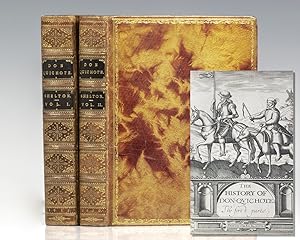
![Bild des Verkäufers für El ingenioso hidalgo Don Quixote de la Mancha; [together with] Segunda parte del ingenioso cavallero don Quixote de la Mancha. zum Verkauf von Peter Harrington. ABA/ ILAB.](https://pictures.abebooks.com/inventory/md/md31307608248.jpg)
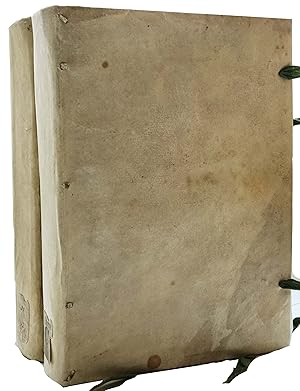

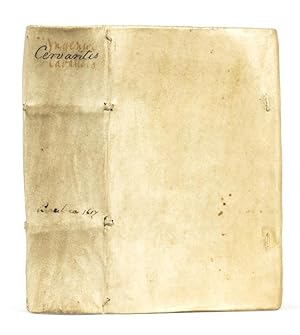
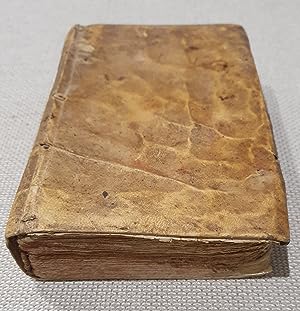
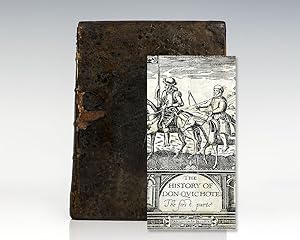
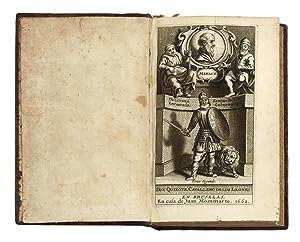
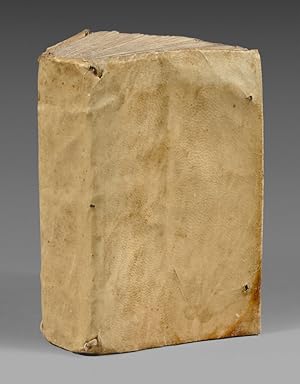
![Bild des Verkäufers für El Ingenioso Hidalgo Don Quixote de la Mancha. - [THE FIRST 'DON QUIXOTE' TO BE PRINTED IN ITALY] zum Verkauf von Lynge & Søn ILAB-ABF](https://pictures.abebooks.com/inventory/md/md30756914760.jpg)
